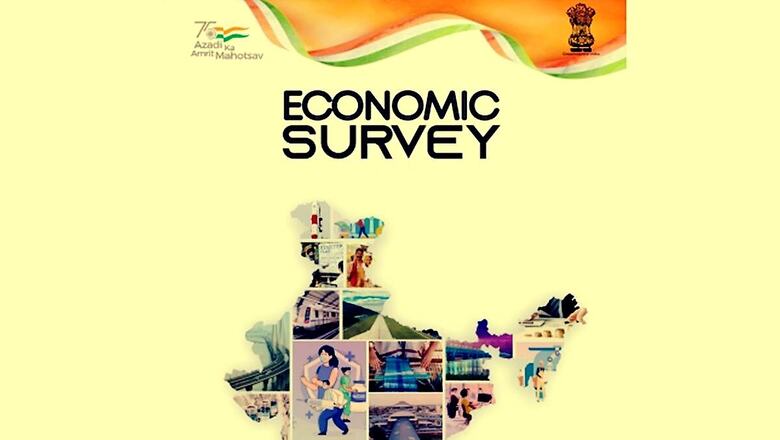
views
Finance Minister Nirmala Sitharaman on Monday tabled the Economic Survey 2023-24 in Parliament, setting the stage for the Union Budget 2024-25. The Survey has unveiled the government’s key areas of policy focus in the short to medium term, both at the macro level and sectoral level. The Budget 2024 will be presented tomorrow, Tuesday, in Parliament.
Here are the policy focus areas of the government:
Generating Productive Employment
According to the Economic Survey 2023-24, productive jobs are vital for growth and inclusion. India’s workforce is estimated to be nearly 56.5 crore, of which more than 45 per cent are employed in agriculture, 11.4 per cent in manufacturing, 28.9 per cent in services, and 13.0 per cent in construction.
“While the services sector remains a major job creator, the construction sector has been rising in prominence lately, driven by the government’s push for infrastructure. However, since construction jobs are largely informal and low-paid, there is a need for avenues for the labour force leaving agriculture. Meanwhile, the manufacturing sector employment creation has been subdued in the past decade due to the legacy of bad loans and appears to have rebounded since 2021-22,” the Survey added.
Skill Gap Challenge
The Economic Survey 2023-24 said 65 per cent of India’s fast-growing population is under 35, and many lack the skills needed by a modern economy. Estimates show that about 51.25 per cent of the youth is deemed employable. In other words, about one in two are not yet readily employable, straight out of college. However, it must be noted that the percentage has improved from around 34 per cent to 51.3 per cent in the last decade.
Tapping the Full Potential of the Agriculture Sector
Despite its centrality in India’s growth trajectory, the agriculture sector continues to face structural issues that have implications for India’s economic growth. The foremost concern confronting the sector pertains to sustaining agriculture growth without letting food price inflation rise beyond acceptable limits while incentivising farmers to raise production.
“There is also a need to improve price discovery mechanisms for agriculture products, increase efficiency, reduce disguised unemployment, address the fragmentation of landholding, and increase crop diversification, among a host of other issues. All of these call for the upgradation of agricultural technology, the application of modern skills in farm practices, enhancing agricultural marketing avenues, price stabilisation, the adoption of innovation in farming, lowering wastages in the use of fertiliser, water, and other inputs, and improving the agriculture-industry linkages,” according to the Economic Survey 2023-24.
Easing the Compliance Requirements, Financing Bottlenecks Confronting MSMEs
MSMEs have played a key role in defining the economic trajectory of some of the major economies, such as Germany, Switzerland, Canada, China, etc. In India, the government has been paying focused attention to enabling the MSME sector to occupy the centre stage in India’s economic story, according to the Economic Survey 2023-24.
“However, the sector continues to face extensive regulation and compliance requirements and faces significant bottlenecks with access to affordable and timely funding being one of the core concerns,” the Survey said.
Managing India’s Green Transition
India has committed to reducing its greenhouse gas (GHG) emissions by 33-35 per cent (from 2005 levels), increasing the share of non-fossil fuel-based electricity to 40 per cent and enhancing forest cover to absorb 2.5 to 3 billion tonnes of carbon dioxide by 2030.
However, the path of green transition in India needs to (a) ensure the consistency of the E-Mobility policy with the required and optimal energy mix between traditional and renewable source; (b) ensure grid stability for E-Mobility to become pervasive; (c) develop or acquire storage technology at affordable costs for the share of renewable energy in power generation to rise; (d) reckon with the opportunity cost of land and capital being used for renewable energy given that India’s needs for land and capital far exceed their availability; and (e) decide on the role and the share of nuclear energy in the energy mix, among others.
The Chinese Conundrum
The dynamics of India-China economic relations continue to be extremely complex and intertwined. The Chinese domination over the global supply chains across product categories is a key global concern, especially in the wake of supply disruption accompanying the war in Ukraine. Even though India is the fastest-growing G20 country and is now recording growth rates that outpace China’s, India’s economy is still a fraction of China’s, it added.
Deepening the Corporate Bond Market
The investment needed to steer India’s economic growth has to be through a multitude of financing options beyond bank financing. India needs both banks and capital markets to provide the required finances sourced from a sustained high level of household savings. An active corporate bond market becomes critical in this context. An efficient corporate bond market with lower costs and quicker issuing time can offer an efficient and cost-effective source of longer-term funds for corporates.
“However, the size of the corporate bond market in India, scaled by GDP, remains small compared to other major Asian emerging markets such as Malaysia, Korea, and China. The Indian corporate bond market lacks depth since it is dominated by highly-rated issuers and a limited investor base of domestic institutions,” the Economic Survey 2023-24.
Tackling Inequality
Globally, widening inequality is emerging as a crucial economic challenge confronting policymakers. The 2022 State of Inequality in India report observed that in India, the top 1 per cent accounts for 6-7 per cent of the total incomes earned, while the top 10 per cent accounts for one-third of total incomes earned, according to the Economic Survey 2023-24.
“The Government places significant focus on this issue and all the critical policy interventions being undertaken with a focus on creating jobs, integrating the informal sector with the formal sector, and expanding the female labour force are aimed at effectively addressing inequality,” it added.
Improving the Quality of Health of India’s Young Population
The Indian Council for Medical Research, in its latest Dietary Guidelines for Indians published in April 2024, estimates that 56.4 per cent of the total disease burden in India is due to unhealthy diets. The report also goes on to observe that the upsurge in the consumption of highly processed foods laden with sugars and fat, coupled with reduced physical activity and limited access to diverse foods, exacerbate micronutrient deficiencies and overweight/obesity problems, said the Economic Survey 2023-24.
“If India needs to reap the gains of its demographic dividend, it is critical that its population’s health parameters transition towards a balanced and diverse diet,” it added.




















Comments
0 comment